| Article ID | Journal | Published Year | Pages | File Type |
|---|---|---|---|---|
| 4971550 | Microelectronics Reliability | 2017 | 8 Pages |
Abstract
This study reports the effect of different types of thermo-mechanical excursion (TME) on growth of intermetallic compound (IMC) layer formed at the interface of Sn-3.0%Ag-0.5%Cu solder and Cu substrate. 1 mm thick solder joints were prepared by reflowing at 270 °C for either 60 or 90 s. Solder joints were then exposed to one of the following TME: (i) isothermal aging at 60 °C for 48, 96 and 144 h, (ii) thermal cycling between â 25 and 125 °C for 100, 200 and 400 cycles, and (iii) thermo-mechanical cycling between â 25 and 125 °C for 100, 200 and 400 cycles, wherein a shear strain of 10% per cycle was imposed on the joint. Finite element analysis (FEA) was performed to ascertain the effects of imposed shear strain and volumetric expansion due to the formation of IMC on the stress field in the solder joint. Irrespective of the type of TME, the thickness of the IMC layer increased with time. However, IMC thickness increased relatively more rapidly under thermo-mechanical cycling condition, indicating strain enhanced coarsening of the interfacial IMC layer. FEA showed that high stresses were generated in the IMC layer and near solder-IMC interface due to the formation of IMC layer as well as imposed external strain, which might then not only enhance the IMC growth kinetics, but also affect the morphology of the IMC layer.
Keywords
Related Topics
Physical Sciences and Engineering
Computer Science
Hardware and Architecture
Authors
Rituparna Ghosh, Anwesha Kanjilal, Praveen Kumar,
